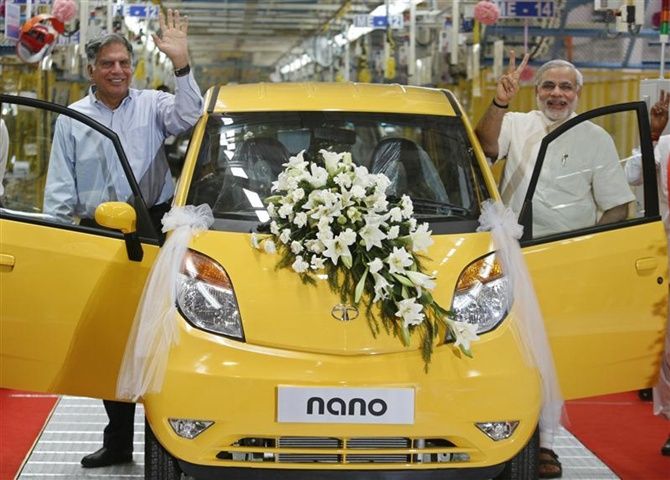The distinction between “cheap” and “affordable” is a fine one, but no one understands this better than India’s aspirational first-time car-owner, says Kanika Datta.

Photograph: Amit Dave/Reuters
Do dwindling sales of the Tata Nano reflect natural market attrition or the hubris of the bottom-of-the-pyramid business model? The latter, the Nano’s brief history suggests. Here is why.
On the face of it, a nine-year run for the Nano appears to be par for the course.

Auto industry professionals put the average market life of a small car at about a decade, though this timeframe is contingent on refurbishing the product or introducing product extensions every fifth or sixth year.
Set against expectations that this “people’s car” alone would more than double the size of the car market at its extraordinary price of Rs 100,000 in 2008 -- about half the cost of the no-frills small car in those days -- the Nano enjoyed a decent run only for about two financial years.

In 2010-2011 and 2011-2012, when annual sales exceeded 70,000 units, though Tata Motors never enjoyed a profit from this appealing little blimp of a car.
From 2012, sales shifted steadily down to hit a little over 1,500 in May to October of the current fiscal year.

This is a long way from its goal of annual sales of 1 million units, which the company announced at the Delhi Auto-Expo launch that Reuters described as a “media circus more worthy of a pop concert or an Oscar ceremony”.
Compared with other “people’s cars”, the Nano was gone in -- pardon the poor pun -- a nano-second.

Excluding the Maruti 800, which enjoyed a three-decade run in conditions of limited competition before it made way for the upgraded Alto, Hyundai’s Santro, the next major small-car challenger, enjoyed a 16-year run, ending up, after a butt-tuck, as the Xing.
And considering that the Nano riveted global attention after Ratan Tata singled out the Financial Times for his announcement, the Nano compares poorly with other famous global “people’s cars”.
The Model T, the car that pioneered assembly line factory production, and was marketed on the principle that those who produced it should be able to afford it, lasted almost two decades starting 1908.

Photograph: Kind courtesy, Neodarkshadow/Wikimedia Commons
It also enjoyed one of the longest production runs in automobile history until another famous people’s car, the Volkswagen Beetle, bettered the record in the early seventies.
Before it was even produced, the Nano was an embodiment of all the imagined virtues of frugal engineering.
But it also attracted publicity for its high-profile exit from Singur, after an unruly argument with a future chief minister of West Bengal, to Sanand in Gujarat, a move that was widely seen as an early endorsement of Narendra Modi as India’s next prime minister.
The judgement on Mamata Banerjee’s anti-industry faults and Mr Modi’s pro-business virtues (remember “Bad M and Good M”?) changed a little when it became clear that, whether in Bengal or Gujarat, the people’s car was being funded pretty much by people’s taxes.

Image: A file photo of the closed Tata Motors Nano car factory in Singur, West Bengal. Photograph: Rupak De Chowdhuri/Reuters
The Left Front government that Ms Banerjee overthrew gave the Tata group 900-odd prime acres and loans at throwaway prices, sales and excise concessions, heavily subsidised power and other giveaways that would last for decades.
Then it turned out that the Modi government in Gujarat had gone even further to attract the Nano plant, with concessions that would, according to one report, benefit the Tata group to the tune of Rs 30,000 crore for 20 years.
This may not sound so extraordinary, since successful “people cars” have rarely been viable without heavy governmental concessions.
In India, we know of Maruti’s antecedents as a government company, which sustained it until Suzuki’s entry.
Bar the Santro, other small cars such as the Daewoo Matiz and the Renault-Bajaj Logan made quick exits from the market.

Globally, the Model T enjoyed a first-mover monopoly in that huckstering business environment of early 20th century America.
But the Volkswagen would never have made it to the market had it not been backed by Adolf Hitler’s dirigist policies, including offering subsidised loans for people to buy the car (it is ironic that the cheap small car the world over retails in India at over Rs 28 lakh, is the Mini Cooper).
Even the most generous of government subsidies cannot compensate for misreading the market, however.
The distinction between “cheap” and “affordable” is a fine one, but no one understands this better than India’s aspirational first-time car-owner.
Add in serious safety doubts and low production values, both banes of the early Nano models, and the world’s cheapest car never stood much of a chance.











